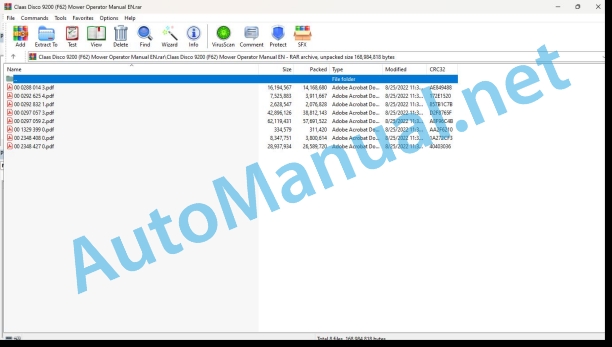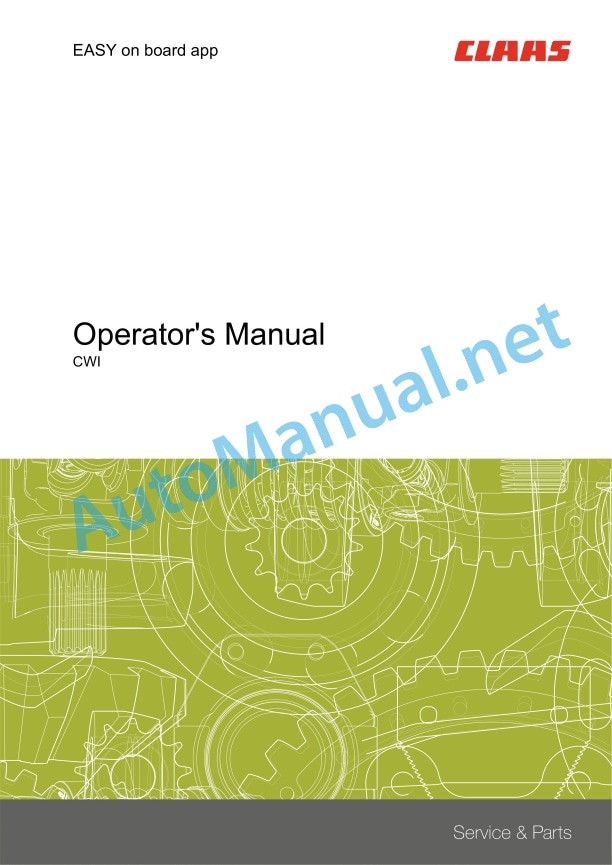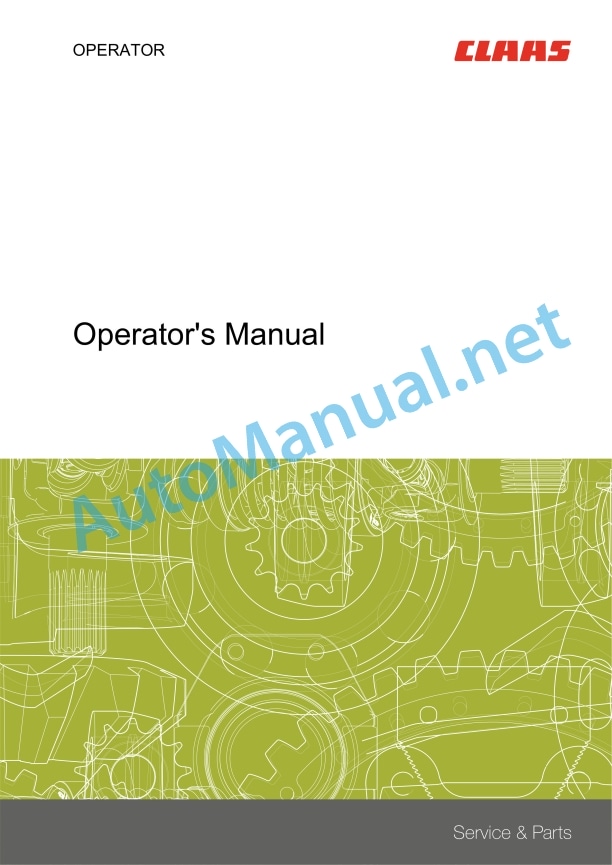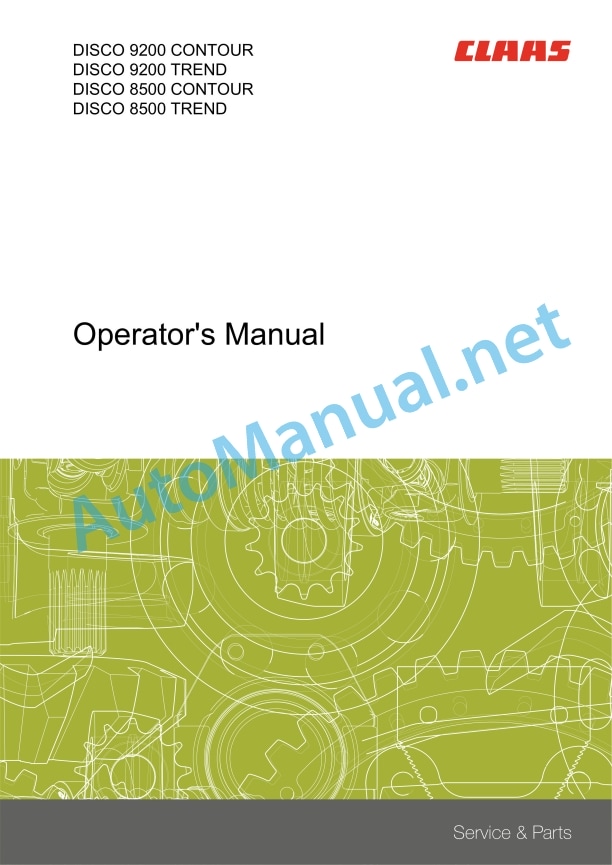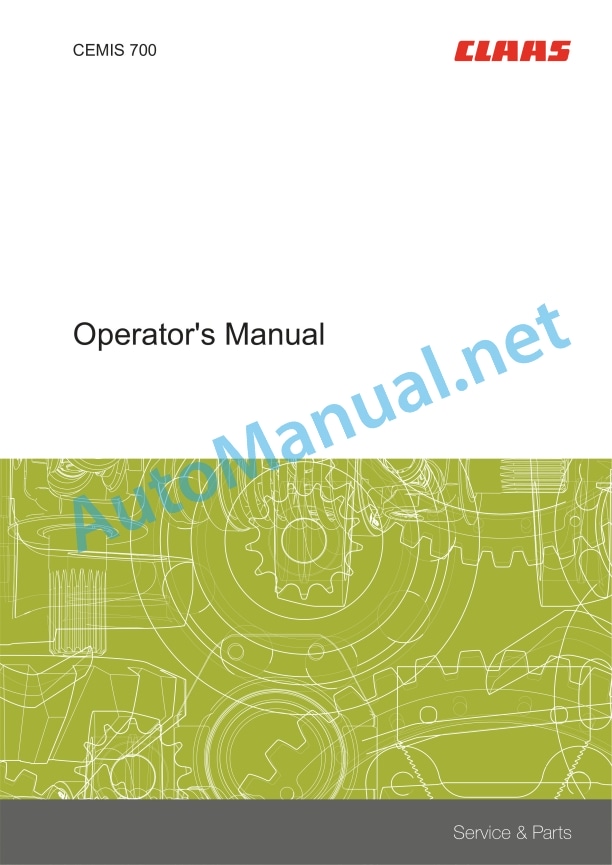Claas Disco 9200 (F62) Mower Operator Manual EN
$50.00
- Model: Disco 9200 (F62) Mower
- Type Of Manual: Operator Manual
- Language: EN
- Format: PDF(s)
- Size: 141 MB
File List:
00 0288 014 3.pdf
00 0292 625 4.pdf
00 0292 832 1.pdf
00 0297 057 3.pdf
00 0297 059 2.pdf
00 1329 399 0.pdf
00 2348 408 0.pdf
00 2348 427 0.pdf
00 0288 014 3.pdf:
EASY on board app
Table of contents
1 Introduction
1.1 General information
1.1.1 Validity of the manual
1.1.2 Information about this Operator’s Manual
1.1.3 Symbols and notes
1.1.4 Qualified specialist workshop
1.1.5 Maintenance notes
1.1.6 Notes on warranty
1.1.7 Spare parts and technical questions
1.1.8 Technical requirements
1.2 Intended use
1.2.1 Intended use
1.2.2 Reasonably foreseeable misuse
2 Safety
2.1 Identifying warnings
2.1.1 Hazard signs
2.1.2 Signal word
2.2 Safety rules
2.2.1 Meaning of Operator’s Manual
2.2.2 Requirements made on all persons working with the product
2.2.3 Hazard areas
2.2.4 Check interactions with self-propelled machines / tractors and implements
2.2.5 Structural changes
2.2.6 Optional equipment and spare parts
2.2.7 Technical status
2.2.8 Hazard caused by damage to the product
2.2.9 Visibility of work area
2.2.10 Glare and reflections
2.2.11 Unintentional triggering of functions
2.2.12 Hazards caused by signal tones
2.2.13 Unauthorised use
2.2.14 Use of mobile terminal outside the cab
2.2.15 Follow the safety instructions
2.2.16 Respecting technical limit values
2.2.17 Preparing the product for road travel
2.2.18 Hazards when driving on the road and on the field
2.2.19 Hazards when driving on the road with an ISOBUS implement
2.2.20 Switching off the mobile terminal while driving
2.2.21 Hazards from disturbance of WLAN environment
2.2.22 Hazards from covering up the App
2.2.23 Hazards caused by malfunctions of the app
2.2.24 Raised machine parts and loads
3 Product description
3.1 Overview and method of operation
3.1.1 Overview of CWI
3.1.2 Functions of CWI
3.2 Identification plates and identification numbers
3.2.1 CWI identification plate
3.3 Information on the product
3.3.1 Factory settings
3.3.2 Software and hardware version
3.3.3 Seal on the CWI
4 Operating and display elements
4.1 CLAAS Wireless Interface (CWI)
4.1.1 CWI operating elements
4.2 CWI Setup App
4.2.1 Overview of screen
4.2.2 Buttons
4.2.3
4.2.4
4.2.5
5 Technical specifications
5.1 CLAAS Wireless Interface (CWI)
5.1.1 Specification
6 Preparing the product
6.1 Installing the product
6.1.1 Installing the CWI Setup app
6.1.2 Installing the EASY on board app
6.1.3 Connecting the tablet
7 Operation
7.1 Initial operation
7.1.1 Establishing the WLAN connection for the first time
7.1.2 Changing factory settings
7.1.3 Establishing the WLAN connection
7.2 CWI Setup App
7.2.1 Calling up menus
7.2.2 Establishing a secure data connection
7.2.3 Deleting a secure data connection
7.2.4 Displaying the software version
7.3 CWI Setup – Settings
7.3.1 Changing settings
7.3.2 Switching LEDs on and off
7.4 CWI setup – Advanced settings
7.4.1 Deleting the connection partner in CWI
7.4.2 Deleting the connection partner on the tablet
7.4.3 Resetting the CWI to factory settings
7.4.4 Resetting the tablet to factory settings
7.4.5 Switching the CAN filter on and off
7.5 EASY on board App
7.5.1 Launching Operator’s Manual
8 Faults and remedies
8.1 Overview of problems
8.1.1 CWI faults
8.1.2 Fault message: USB charging connection was disconnected
8.1.3 Fault message: Tablet outside WLAN reception area
8.1.4 Fault message: Screen locked
9 Maintenance
9.1 Maintenance schedules
9.1.1 Daily
9.2 Tablet
9.2.1 Cleaning the tablet
9.2.2 Downloading software updates
9.2.3 Updating the operating system
10 Putting out of operation and disposal
10.1 General information
10.1.1 Decommissioning and disposal
11 EC declaration of conformity
11.1 CLAAS Wireless Interface (CWI)
11.1.1 EU Declaration of conformity
12 Technical terms and abbreviations
12.1 Terms and explanations
12.1.1 Abbreviations
12.1.2 Technical terms
00 0292 625 4.pdf:
COMMUNICATOR II
Table of contents
1 Introduction
1.1 Notes on the manual
1.1.1 Validity of manual
1.1.2 Information about this Operator’s Manual
1.1.3 Symbols and notes
1.1.4 Optional equipment
1.1.5 Qualified specialist workshop
1.1.6 Maintenance notes
1.1.7 Notes on warranty
1.1.8 Spare parts and technical questions
1.2 Intended use
1.2.1 Intended use
1.2.2 Reasonably foreseeable misuse
2 Safety
2.1 Identifying warnings
2.1.1 Hazard signs
2.1.2 Signal word
2.2 Safety rules
2.2.1 Meaning of Operator’s Manual
2.2.2 Requirements made on all persons working with the product
2.2.3 Hazard areas
Hazard areas
2.2.4 Interaction between the control terminal and the machine or tractor
2.2.5 Structural changes
2.2.6 Optional equipment and spare parts
2.2.7 Technical status
2.2.8 Danger from damage to the machine
2.2.9 Complying with technical limit values
2.2.10 Preparing the product for road travel
2.2.11 Hazards when driving on the road and in the field
2.2.12 Hazards when driving on the road with an ISOBUS implement
2.2.13 Switching off the terminal while driving
2.2.14 Electrocution by electrical system
2.2.15 Only carry out work on the machine when it is stopped
2.2.16 Maintenance operations and repair work
2.2.17 Raised machine parts and loads
2.2.18 Welding work prohibited
3 Product description
3.1 Overview and method of operation
3.1.1 Overview of COMMUNICATOR II
3.1.2 Function of COMMUNICATOR II
3.2 Identification plates and identification numbers
3.2.1 Identification plate of COMMUNICATOR II
4 Operating and display elements
4.1 COMMUNICATOR II
4.1.1 Terminal
4.1.2 Terminal program
4.2 Universal terminal menu structure (service)
4.2.1 Main menu of universal terminal
4.2.2
4.2.3
4.2.4
4.2.5
4.3 Job processing (task) menu structure
4.3.1 Job processing main menu
4.3.2
4.3.3
4.3.4
4.3.5
4.3.6
5 Technical specifications
5.1 COMMUNICATOR II
5.1.1 Specification
6 Preparing the product
6.1 Switching off and securing the machine
6.1.1 Shut down and secure the machine
7 Operation
7.1 Switching COMMUNICATOR II on/off
7.1.1 Switching COMMUNICATOR II on
7.1.2 Selecting the application
7.1.3 Switching off COMMUNICATOR II
7.2 Programmable keys
7.2.1 Displaying the key assignment
7.2.2 Creating a key assignment
Step 1: Selecting the control and the key
00 0292 832 1.pdf:
OPERATOR
Table of contents
1 To this Operator’s Manual
1.1 Notes on the manual
1.1.1 Validity of the manual
1.1.2 Using the manual
1.1.3 Symbols and notes
1.1.4 Technical specifications
2 Safety
2.1 Safety rules
2.1.1 Particularly important
2.1.2 Intended use
2.1.3 Reasonably foreseeable misuse
2.1.4 General safety and accident prevention regulations
3 Product description
3.1 Overview and method of operation
3.1.1 OPERATOR overview
3.1.2 OPERATOR mode of operation
3.2 Identification plates and identification numbers
3.2.1 Spare parts and technical questions
3.2.2 OPERATOR identification plate
4 Operating and display elements
4.1 CLAAS OPERATOR
4.1.1 Terminal
4.1.2 Terminal program
4.1.3 Menu overview
4.1.4 Information menu
4.1.5 Settings menu
4.1.6 Time menu
4.1.7 Diagnosis menu
4.1.8 Language and units menu
5 Technical specifications
5.1 CLAAS OPERATOR
5.1.1 Specification
6 Operation
6.1 Switching the OPERATOR on and off
6.1.1 Switching on the OPERATOR
6.1.2 Selecting an application
6.1.3 Switching off the OPERATOR
6.2 Terminal settings
6.2.1 Adjusting the screen and volume
Day mode
Night mode
6.2.2 Adjusting the date and time
6.2.3 Displaying the diagnosis information
On-board voltage display (1)
Enabling the speed signal (2)
Displaying the CLAAS ISOBUS ECU address and name (3)
6.2.4 Setting the language and display formats
Setting the language
Setting the display formats
7 Maintenance
7.1 Maintenance
7.1.1 Daily
8 Putting out of operation and disposal
8.1 General information
8.1.1 Putting out of operation and disposal
9 Technical terms and abbreviations
9.1 Terms and explanations
9.1.1 Technical words
9.1.2 Abbreviations
00 0297 057 3.pdf:
DISCO 9200 CONTOURDISCO 9200 TRENDDISCO 8500 CONTOURDISCO 8500 TREND
Table of contents
1 Introduction
1.1 Notes on the manual
1.1.1 Validity of manual
1.1.2 Information about this Operator’s Manual
1.1.3 Symbols and notices
1.1.4 Optional equipment
1.1.5 Qualified specialist workshop
1.1.6 Notes on warranty
1.1.7 Spare parts and technical questions
1.2 Intended use
1.2.1 Intended use
1.2.2 Reasonably foreseeable misuse
2 Safety
2.1 Identifying warnings
2.1.1 Hazard signs
2.1.2 Signal word
2.2 Safety rules
2.2.1 Importance of Operator’s Manual
2.2.2 Observing safety decals and warnings
2.2.3 Requirements for all persons working with the machine
2.2.4 Children in danger
2.2.5 Hazard areas
2.2.6 Staying between the tractor and the machine
2.2.7 Hitching the tractor to the machine
2.2.8 Risk of injury from rotating shafts
2.2.9 Structural changes
2.2.10 Optional equipment and spare parts
2.2.11 Control of the machine while it is running
2.2.12 Operation only after proper putting into operation
2.2.13 Technical condition
2.2.14 Danger due to damage to the machine
2.2.15 Respecting technical limit values
2.2.16 Danger from machine parts running on
2.2.17 Keeping protective equipment functional
2.2.18 Personal protective equipment
2.2.19 Wearing suitable clothing
2.2.20 Removing dirt and loose objects
2.2.21 Preparing the machine for road travel
2.2.22 Hazards when driving on the road and in the field
2.2.23 Parking the machine safely
2.2.24 Unsupervised parking
2.2.25 Unsuitable operating materials
2.2.26 Safe handling of operating and auxiliary materials
2.2.27 Environmental protection and disposal
2.2.28 Lethal electrocution from overhead lines
2.2.29 Behaviour in case of voltage flash-over from overhead lines and when lightning strikes
2.2.30 Noise may cause health damage
2.2.31 Liquids under pressure
2.2.32 Hot surfaces
2.2.33 Only carry out work on the machine when it is shut down
2.2.34 Maintenance operations and repairs
2.2.35 Lifted machine parts and loads
2.2.36 Danger from welding work
2.3 Safety decals on the machine
2.3.1 Layout of safety decals
2.3.2 Safety decals on the machine
3 Machine description
3.1 Overview and method of operation
3.1.1 Machine overview
3.1.2 Overview of cutting disc direction of rotation
3.1.3 Functions of the machine
3.2 Optional equipment
3.2.1 High-cut skids*
3.2.2 Double high-cut skids*
3.2.3 Wear skids*
3.2.4 Bar protection*
3.2.5 Outer swathing disc*
3.2.6 Slip-on yoke for 21-piece universal drive shaft*
3.2.7 OPERATOR*
3.2.8 EASY on board App*
Requirements made on the tablet (not included in the shipping package)
3.2.9 ISOBUS connecting cable*
3.2.10 Ground speed signal cable*
3.2.11 Order printer for ISOBUS*
3.2.12 Front speed monitoring* and digital pressure indicator*
3.2.13 Battery cable*
3.2.14 Lighting adapter for USA*
3.2.15 Hydraulically folding safety frames*
3.2.16 Individual lifting function*
3.2.17 Lower link pin, category II*
3.2.18 Adapter balls, category IV*
3.2.19 Legal equipment for France*
3.3 Identification plate and vehicle identification number
3.3.1 Spare parts and technical questions
3.3.2 Machine identification plate
3.4 Information on the machine
3.4.1 Marking of pressure gauge, setting aid, machine frame and arm
3.4.2 Stickers on the machine
3.4.3 Program version
4 Operating and control elements
4.1 Controls
4.1.1 Hydraulic hose
4.1.2 Mounting frame
4.1.3 Hydraulic system
4.2 Display elements
4.2.1 Pressure gauge
4.2.2 Adjusting aid
4.3 OPERATOR
4.3.1 Overview of OPERATOR*
4.4 Monitor
4.4.1 Overview of monitor
4.4.2 Menu bar
4.4.3 Status bar
4.5
4.5.1 Mower units in transport position
4.5.2 Mower units in working position
4.5.3
4.6
4.6.1 Overview of
4.6.2 Overview of
4.6.3 Overview of
4.7
4.7.1
4.7.2 Overview of
4.8
4.8.1 Overview of
4.8.2 Machine performance total counter
4.9
4.9.1
4.9.2 Basic adjustment (Initialising)
5 Technical specifications
5.1 DISCO 9200 CONTOUR
5.1.1 Dimensions
5.1.2 Weights
5.1.3 Requirements for the tractor
5.1.4 Design
5.1.5 Sound pressure level
5.1.6 Lubricants
5.2 DISCO 9200 TREND
5.2.1 Dimensions
5.2.2 Weights
5.2.3 Requirements for the tractor
5.2.4 Design
5.2.5 Sound pressure level
5.2.6 Lubricants
5.3 DISCO 8500 CONTOUR
5.3.1 Dimensions
5.3.2 Weights
5.3.3 Requirements for the tractor
5.3.4 Design
5.3.5 Sound pressure level
5.3.6 Lubricants
5.4 DISCO 8500 TREND
5.4.1 Dimensions
5.4.2 Weights
5.4.3 Requirements for the tractor
5.4.4 Design
5.4.5 Sound pressure level
5.4.6 Lubricants
6 Machine preparation
6.1 Switching off and securing the machine
6.1.1 Switch off and secure the tractor and machine
6.1.2 Securing the raised machine
6.2 Adapting the tractor
6.2.1 Checking the ballasting of the tractor
Calculating the minimum front ballast
Calculating the minimum rear ballast
Calculating the actual front axle load
Calculating the actual total weight
Calculating the actual rear axle load
Calculation table
6.2.2 Attaching the bracket for the individual lifting function operator panel*
6.2.3 Installing the OPERATOR*
6.2.4 Marking hydraulic hose line connections on the tractor
6.3 Adapting the machine
6.3.1 Universal drive shaft – checking the length
6.3.2 Adapting the length of the universal drive shaft
6.3.3 Fitting the universal drive shaft to the machine
6.3.4 Adapting the lower and upper link category
Adapting the lower link category
Adapting the upper link category
6.3.5 Adapting the lower link pin position
6.3.6 Attaching the double high-cut skids*
6.3.7 Installing the high-cut skids*
6.3.8 Removing the high-cut skids*
6.3.9 Installing wear skids*
6.3.10 Adapting the overlap
Relocating mower units
6.4 Hitching the machine
6.4.1 Fitting the lower link
6.4.2 Fitting the upper link
6.4.3 Installing the universal drive shaft
6.4.4 Attaching the hydraulic hose connections for the hydraulic lift
6.4.5 Attaching the hydraulic hose connections for the hydraulic lift
6.4.6 Attach the hydraulic hose connections for load relief
6.4.7 Connecting the lighting cable
6.4.8 Connecting the OPERATOR*
6.4.9 Connecting the individual lifting function*
6.4.10 Raising the stands
6.5 Unhitching the machine
6.5.1 Lowering the stands
6.5.2 Disconnecting the OPERATOR*
6.5.3 Disconnecting the lighting cable
6.5.4 Detach the hydraulic hose connection for the load relief
6.5.5 Disconnecting the hydraulic hoses for lifting
6.5.6 Disconnecting the hydraulic hoses for lifting
6.5.7 Disconnecting individual lifting function*
6.5.8 Removing the universal drive shaft
6.5.9 Unhinging the upper link
6.5.10 Unhinging the lower link
6.6 Prepare road travel
6.6.1 Folding up the lateral safety guard holders
6.6.2 Lifting to transport position
6.6.3 Lifting to transport position
6.7 Preparing the working position
6.7.1 Lowering to working position
6.7.2 Lowering to working position
6.7.3 Folding down the lateral safety guards
6.8 Loading the machine
6.8.1 Loading the machine
7 Operation
7.1 General safety precautions
7.1.1 Prior to operation
7.2 Driving on the road
7.2.1 Driving on public roads
7.2.2 Transport width with double high-cut skids* fitted
7.3 Fieldwork settings
7.3.1 Adjusting the attachable frame
7.3.2 Adjusting the load relief of the mower units
7.3.3 Overview of balancing pressure settings
Overview of balancing pressure settings
7.3.4 Adjusting the outer swath disc*
7.3.5 Adjusting the cutting height
7.3.6 Engaging collision protection
7.3.7 Retensioning the collision protection
7.4 Fieldwork
7.4.1 To be observed during fieldwork
7.4.2 Machine use
7.4.3 Adapting the PTO speed
7.4.4 Mowing methods
7.4.5 Headland position
7.4.6 Headland position
7.4.7 Instructions for mowing
7.4.8 Difficult conditions of use
7.4.9 Recommendation for environmental protection
7.5 Operating the individual lifting function*
7.5.1 Operating the individual lifting function* with the mechanical control device
7.5.2 Operating the individual lifting function* using the multifunction control lever
7.5.3 Operating the individual lifting function* with the Fendt Vario tractor ground speed control lever
Fendt Vario 900 SCR/900 S4/800 SCR/800 S4/700 SCR/700 S4
7.6 ISOBUS control unit
7.6.1 Validity of ISOBUS control
7.6.2 Description
General instructions
7.6.3 Explanations of ISOBUS terminology
7.7 OPERATOR
7.7.1 OPERATOR* recommendations
7.7.2 Operating the OPERATOR*
7.8 EASY on board App
7.8.1 EASY on board App* recommendations
7.8.2 Operation of the EASY on board App*
7.9 Switching the terminal on and off
7.9.1 Switching on the terminal
7.9.2 Starting the control program
7.9.3 Pressing keys
7.9.4 Switching off the terminal
7.9.5 Switching off the control program automatically
7.9.6 Changing the menu
7.10 Control unit transport position
7.10.1 Lifting mower units into the transport position
7.10.2 Lowering the mower units from the transport position
7.11 Control unit working position
7.11.1 Lifting and lowering both mower units
7.11.2 Lifting and lowering mower units individually
7.11.3 Deactivating the mower unit individual lift automatically
7.11.4 Saving the height settings of the mounting frame
7.12 Safety guard control
7.12.1 Folding the safety guards
7.13 Control unit, settings
7.13.1 Adjusting the headland height
7.13.2 Adjusting the load relief of the mower units
7.13.3 Adjusting the overlap when driving along a crop edge
7.14 Control unit, drive monitoring
7.14.1 Drive monitoring
7.14.2 Setting the maximum speed difference
7.14.3 Listen to the signal tone
7.15 Control unit, maintenance counter
7.15.1 Maintenance alarm
Deleting the maintenance alarm
7.16 Control unit, order management
7.16.1 Displaying order data
Order-dependent counters
Order-independent counters
Selecting an order
Printing an order
7.16.2 Creating a job
7.16.3 Switching data recording on and off
7.16.4 Activating and deactivating the area counter for the front mower unit
7.16.5 Displaying recorder summaries for machine performance
7.17 Control unit, fault messages
7.17.1 Alarm screen
7.17.2 Warning message: Front mower connecting cable
7.17.3 Sensor faults
7.18 Control unit, basic settings (initialisation)
7.18.1 Learning the end stop
7.18.2 Restoring factory settings
Factory settings
7.18.3 Reloading the control programme
7.19 ISOBUS Auxiliary function (AUX)
7.19.1 Available functions
7.19.2 Programmable keys for the CLAAS tractor
CEBIS version of CLAAS AXION 900 / AXION 800 / ARION 600
7.19.3 Converting the FENDT Vario tractor terminal
7.19.4 Programmable keys for the Fendt Vario tractor
Fendt Vario 900 SCR / 900 S4 / 800 SCR / 800 S4 / 700 SCR / 700 S4 – suggestion 1
8 Faults and remedies
8.1 Overview of problems
8.1.1 Faults on the machine
8.1.2 Fault code table
8.2 Electrical and electronic system
8.2.1 Defective cable fuse
8.2.2 Checking and adjusting the angular sensors
8.2.3 Defective incandescent lamps
8.3 Mower unit
8.3.1 The cutting disc no longer turns
9 Maintenance
9.1 Service interval overview
9.1.1 Before the harvest
9.1.2 After the first 50 operating hours
9.1.3 Every 8 operating hours
9.1.4 Every 20 operating hours
9.1.5 Every 100 operating hours
9.1.6 Every 250 operating hours
9.1.7 Every 500 operating hours or annually
9.1.8 Every 5 years
9.1.9 After the harvest
9.2 Gearbox
9.2.1 Checking the gearbox for leaks
9.2.2 Check the oil level in the main gearbox
9.2.3 Changing the oil in the main gearbox
9.2.4 Checking the oil level in the angle drive
9.2.5 Changing the oil in the angle drive
9.3 Clutch
9.3.1 Check the overload clutch
9.3.2 Removing the friction clutch
9.3.3 Attaching the friction clutch
9.3.4 Venting the friction clutch
9.3.5 Checking the friction plates
9.3.6 Clean the friction clutches for the universal drive shafts
9.4 Universal drive shaft
9.4.1 Servicing the universal drive shafts
9.5 Hydraulic system
9.5.1 Reducing the pressure in the hydraulic system
9.5.2 Checking the hydraulic hoses
9.5.3 Checking the accumulator
9.5.4 Removing the load relief cylinders
9.5.5 Fitting the load relief cylinders
9.6 Mower unit
9.6.1 Checking the oil level in the mower heads
9.6.2 Changing the mower head oil
Draining oil on the right and left
Filling in oil on the right and left
9.6.3 Check the mower knives
9.6.4 Replacing the mower knives
9.6.5 Check the mower knife holder
9.6.6 Check the adapters
9.6.7 Clean the drain opening of the feed drum
9.6.8 Check the wear bars of the feed drum
9.6.9 Check the cover plate on the feed drum
9.6.10 Check the sealing washer of the feed drum
9.6.11 Check the cutting discs
9.6.12 Replacing the cutting discs
9.6.13 Adjusting the anti-wrap guard
9.7 Assembly parts and bodywork
9.7.1 Clean the machine
9.7.2 Preserve the machine
9.7.3 Checking the fittings
9.7.4 Check the safety guard holder
Tightening torques for the hex. nuts (3)
9.8 Lubrication plan
9.8.1 Lubricate greasing points every 8 operating hours
9.8.2 Lubricate greasing points every 20 operating hours
9.8.3 Lubricating grease points every 100 operating hours
9.8.4 Lubricating grease points every 250 operating hours
9.8.5 Lubricate greasing points every 500 operating hours or once a year
10 Putting out of operation and disposal
10.1 General information
10.1.1 Placing out of operation and disposal
11 EC declaration of conformity
11.1 DISCO 9200 CONTOUR / 8500 CONTOUR
11.1.1 EC Declaration of Conformity
11.2 DISCO 9200 TREND / 8500 TREND
11.2.1 EC Declaration of Conformity
12 Technical terms and abbreviations
12.1 Terms and explanations
12.1.1 Technical terms
12.1.2 Abbreviations
00 0297 059 2.pdf:
DISCO 9200 BUSINESS
Table of contents
1 To this Operator’s Manual
1.1 Notes on the manual
1.1.1 Validity of manual
1.1.2 Information about this Operator’s Manual
1.1.3 Symbols and notices
1.1.4 Optional equipment
1.1.5 Qualified specialist workshop
1.1.6 Notes on warranty
1.1.7 Spare parts and technical questions
1.2 Intended use
1.2.1 Intended use
1.2.2 Reasonably foreseeable misuse
2 Safety
2.1 Identifying warnings
2.1.1 Hazard signs
2.1.2 Signal word
2.2 Safety rules
2.2.1 Meaning of Operator’s Manual
2.2.2 Observing safety decals and warnings
2.2.3 Requirements for all persons working with the machine
2.2.4 Children in danger
2.2.5 Hazard areas
2.2.6 Staying between the tractor and the machine
2.2.7 Hitching the tractor to the machine
2.2.8 Risk of injury from rotating shafts
2.2.9 Structural changes
2.2.10 Optional equipment and spare parts
2.2.11 Control of the machine while it is running
2.2.12 Operation only after proper putting into operation
2.2.13 Technical condition
2.2.14 Danger due to damage to the machine
2.2.15 Respecting technical limit values
2.2.16 Danger from machine parts running on
2.2.17 Keeping the safety devices functional
2.2.18 Personal protective equipment
2.2.19 Wearing suitable clothing
2.2.20 Removing dirt and loose objects
2.2.21 Preparing the machine for road travel
2.2.22 Hazards when driving on the road and in the field
2.2.23 Parking the machine safely
2.2.24 Unsupervised parking
2.2.25 Unsuitable operating materials
2.2.26 Safe handling of operating and auxiliary materials
2.2.27 Environmental protection and disposal
2.2.28 Lethal electrocution from overhead lines
2.2.29 Behaviour in case of voltage flash-over from overhead lines and when lightning strikes
2.2.30 Noise may cause health damage
2.2.31 Liquids under pressure
2.2.32 Hot surfaces
2.2.33 Only carry out work on the machine when it is stopped
2.2.34 Maintenance operations and repairs
2.2.35 Lifted machine parts and loads
2.2.36 Danger from welding work
2.3 Safety decals on the machine
2.3.1 Notes on safety decals
2.3.2 Safety decals on the machine
3 Machine description
3.1 Overview and method of operation
3.1.1 Machine overview
3.1.2 Overview of the cutting disc direction of rotation
3.1.3 Function of machine
3.2 Optional equipment
3.2.1 High-cut skids*
3.2.2 Double high-cut skids*
3.2.3 Wear skids*
3.2.4 Bar protection*
3.2.5 Hydraulic coupling as per ISO 16028*
3.2.6 Slip-on yoke for 21-piece universal drive shaft*
3.2.7 Adapter balls, category IV*
3.2.8 Lower link pin, category II*
3.2.9 COMMUNICATOR II*
3.2.10 OPERATOR*
3.2.11 EASY on board App*
Requirements made on the tablet (not included in the shipping package)
3.2.12 ISOBUS connecting cable*
3.2.13 Extension cable*
3.2.14 Speed signal cable*
3.2.15 Battery cable*
3.2.16 Order printer* for ISOBUS
3.2.17 Front speed monitoring* and digital pressure indicator*
3.2.18 Actuation of the hydraulically folding front safety guards*
3.2.19 ACTIVE FLOAT adjustment, front*
3.2.20 Work lighting*
3.2.21 Lighting adapter for USA*
3.2.22 Legal equipment for France*
3.3 Identification plate and vehicle identification number
3.3.1 Machine identification plate
3.4 Information on the machine
3.4.1 Program version
3.4.2 Stickers on the machine
4 Operating and display elements
4.1 Controls
4.1.1 Mounting frame
4.2 Display elements
4.2.1 Pressure gauge
4.2.2 Adjusting aid
4.3 Monitor
4.3.1 Display variants
4.3.2 Overview of monitor
4.3.3 Menu bar
4.3.4 Status bar
4.4
4.4.1 Mower units in transport position
4.4.2 Mower unit in working position
4.4.3
4.5
4.5.1
4.5.2
4.5.3
4.6
4.6.1
4.6.2
4.6.3
4.7
4.7.1
4.7.2
4.8
4.8.1 Overview of
4.8.2
4.8.3 Recorder summaries for machine performance
4.9
4.9.1 Overview of
4.9.2 Basic settings (initialising)
4.9.3
5 Technical specifications
5.1 DISCO 9200 BUSINESS
5.1.1 Dimensions
5.1.2 Weights
5.1.3 Requirements for the tractor
5.1.4 Design
5.1.5 Sound pressure level
5.1.6 Lubricants
6 Machine preparation
6.1 Switching off and securing the machine
6.1.1 Switching off and securing the tractor and machine
6.1.2 Securing the raised machine
6.2 Adapting the tractor
6.2.1 Checking the ballasting of the tractor
Calculating the minimum front ballast
Calculating the minimum rear ballast
Calculating the actual front axle load
Calculating the actual total weight
Calculating the actua
John Deere Repair Technical Manual PDF
John Deere Parts Catalog PDF
John Deere Tractors 7500 Parts Catalog CPCQ26568 30 Jan 02 Portuguese
John Deere Repair Technical Manual PDF
John Deere Repair Technical Manual PDF
John Deere Parts Catalog PDF
John Deere Tractors 6300, 6500, and 6600 Parts Catalog CQ26564 (29SET05) Portuguese
John Deere Repair Technical Manual PDF
John Deere 16, 18, 20 and 24HP Onan Engines Component Technical Manual CTM2 (19APR90)
John Deere Repair Technical Manual PDF
John Deere Application List Component Technical Manual CTM106819 24AUG20
John Deere Repair Technical Manual PDF
John Deere Transmission Control Unit Component Technical Manual CTM157 15JUL05
John Deere Repair Technical Manual PDF
John Deere Diesel Engines PowerTech 4.5L and 6.8L – Motor Base Technical Manual 07MAY08 Portuguese
John Deere Repair Technical Manual PDF

